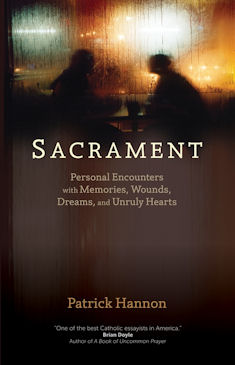
|
Posted September 26, 2014
Book: Sacrament: Personal Encounters with Memories, Wounds, Dreams, and Unruly Hearts Author: Patrick Hannon Ave Maria Press. Notre Dame, IN. 2014. Pp. 115 An Excerpt from the Jacket:
In the tradition of such writers as Anne Larnott, Richard Rodriguez, and Barry Lopez, Patrick Hannon takes his readers on a captivating spiritual journey with unexpected turns and delightful characters. In Sacrament, Hannon guides readers through his own everyday sacramental encounters as living, breathing moments with God. Each essay is a carefully crafted metaphor of one of the sacraments , and Hannon shows moments of deeply human interaction to indeed be encounters with divine grace. An Excerpt from the Book: Mother Teresa, the saint of Calcutta, insisted that, upon her death, her spiritual directory destroy the letters she had written to him over decades of correspondence. I can see why. She exposed her deepest secrets in them, and so they count, I think, among the greatest love letters ever written. In one she wrote, This sense of loss --- this untold darkness --- this loneliness --- this continual longing for God --- which gives me that pain deep down in my heart --- Darkness is such that I really do not see . . . There is no God in me . . . God does not want me, --- Sometimes --- I just hear my own heart cry out --- "My God" and nothing else comes --- the torture and pain I can't explain. Years later she wrote in another, "There is so much contradiction in my soul --- Such deep longing for God . . . a suffering continual --- and yet not wanted by God --- repulsed --- empty --- no faith --- no love --- no zeal . . . Heaven means nothing." Mother Teresa went about her day doing good and trying to fend off the darkness. For her it meant preaching hope in dark places. Secretly, she was baring her sallow soul in letters to the one human being she trusted. All those long, damning dashes, denoting doubt and hesitation. They were saved and eventually published. Far from casting her in an unflattering light, those letters --- thankfully preserved --- introduce us, as if for the first time, to Agnes Bojaxhiu, the woman beneath the blue-striped habit and veil. Perhaps, as with Mother Theresa, we become accomplices in the demolition of our protected selves every time we put pen to stationary and dare to put into writing what we would never utter aloud. Once we mail a love letter, I think it is safe to say, we cede control over our lives, or its cohesive narrative, to someone else. The love letter gives the beloved a privileged peek behind the mask. We see the great man in his pajamas, the starlet without makeup. Emerson said such letters were a "kind of picture of a voice", what a humbling stripped-down picture it is, and human. At some point, possibly years later, someone --- a son or daughter, a grandchild, a distant relative, or the whole world perhaps --- could happen upon them and come to know your secret self. I'm beginning to think this wouldn't be such a bad thing. Table of Contents: Introduction: in a field of tall grass 1. Baptism 2. Confession 3. Eucharist 4. Confirmation 5. Matrimony 6. Holy Orders 7. Anointing of the sick |
|
